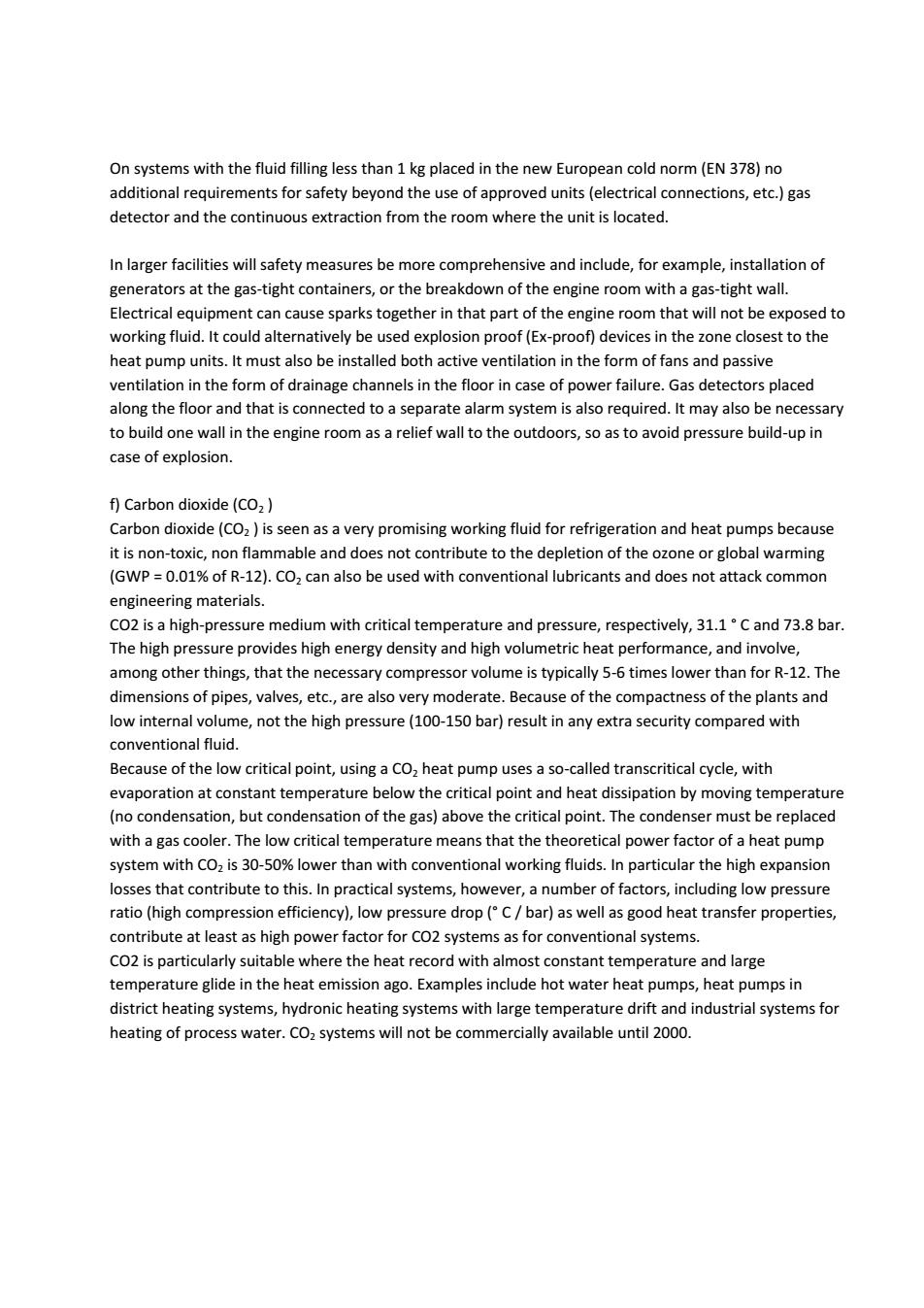正在加载图片...

On systems with the fluid filling less than 1 kg placed in the new European cold norm(EN 378)no additional requirements for safety beyond the use of approved units(electrical connections,etc.)gas detector and the continuous extraction from the room where the unit is located. In larger facilities will safety measures be more comprehensive and include,for example,installation of generators at the gas-tight containers,or the breakdown of the engine room with a gas-tight wall. Electrical equipment can cause sparks together in that part of the engine room that will not be exposed to working fluid.It could alternatively be used explosion proof(Ex-proof)devices in the zone closest to the heat pump units.It must also be installed both active ventilation in the form of fans and passive ventilation in the form of drainage channels in the floor in case of power failure.Gas detectors placed along the floor and that is connected to a separate alarm system is also required.It may also be necessary to build one wall in the engine room as a relief wall to the outdoors,so as to avoid pressure build-up in case of explosion. f)Carbon dioxide(CO,) Carbon dioxide(CO2)is seen as a very promising working fluid for refrigeration and heat pumps because it is non-toxic,non flammable and does not contribute to the depletion of the ozone or global warming (GWP =0.01%of R-12).CO2 can also be used with conventional lubricants and does not attack common engineering materials. CO2 is a high-pressure medium with critical temperature and pressure,respectively,31.1C and 73.8 bar. The high pressure provides high energy density and high volumetric heat performance,and involve, among other things,that the necessary compressor volume is typically 5-6 times lower than for R-12.The dimensions of pipes,valves,etc.,are also very moderate.Because of the compactness of the plants and low internal volume,not the high pressure(100-150 bar)result in any extra security compared with conventional fluid. Because of the low critical point,using a cO,heat pump uses a so-called transcritical cycle,with evaporation at constant temperature below the critical point and heat dissipation by moving temperature (no condensation,but condensation of the gas)above the critical point.The condenser must be replaced with a gas cooler.The low critical temperature means that the theoretical power factor of a heat pump system with COz is 30-50%lower than with conventional working fluids.In particular the high expansion losses that contribute to this.In practical systems,however,a number of factors,including low pressure ratio(high compression efficiency),low pressure drop(C/bar)as well as good heat transfer properties, contribute at least as high power factor for CO2 systems as for conventional systems. CO2 is particularly suitable where the heat record with almost constant temperature and large temperature glide in the heat emission ago.Examples include hot water heat pumps,heat pumps in district heating systems,hydronic heating systems with large temperature drift and industrial systems for heating of process water.CO2 systems will not be commercially available until 2000.On systems with the fluid filling less than 1 kg placed in the new European cold norm (EN 378) no additional requirements for safety beyond the use of approved units (electrical connections, etc.) gas detector and the continuous extraction from the room where the unit is located. In larger facilities will safety measures be more comprehensive and include, for example, installation of generators at the gas-tight containers, or the breakdown of the engine room with a gas-tight wall. Electrical equipment can cause sparks together in that part of the engine room that will not be exposed to working fluid. It could alternatively be used explosion proof (Ex-proof) devices in the zone closest to the heat pump units. It must also be installed both active ventilation in the form of fans and passive ventilation in the form of drainage channels in the floor in case of power failure. Gas detectors placed along the floor and that is connected to a separate alarm system is also required. It may also be necessary to build one wall in the engine room as a relief wall to the outdoors, so as to avoid pressure build-up in case of explosion. f) Carbon dioxide (CO2 ) Carbon dioxide (CO2 ) is seen as a very promising working fluid for refrigeration and heat pumps because it is non-toxic, non flammable and does not contribute to the depletion of the ozone or global warming (GWP = 0.01% of R-12). CO2 can also be used with conventional lubricants and does not attack common engineering materials. CO2 is a high-pressure medium with critical temperature and pressure, respectively, 31.1 ° C and 73.8 bar. The high pressure provides high energy density and high volumetric heat performance, and involve, among other things, that the necessary compressor volume is typically 5-6 times lower than for R-12. The dimensions of pipes, valves, etc., are also very moderate. Because of the compactness of the plants and low internal volume, not the high pressure (100-150 bar) result in any extra security compared with conventional fluid. Because of the low critical point, using a CO2 heat pump uses a so-called transcritical cycle, with evaporation at constant temperature below the critical point and heat dissipation by moving temperature (no condensation, but condensation of the gas) above the critical point. The condenser must be replaced with a gas cooler. The low critical temperature means that the theoretical power factor of a heat pump system with CO2 is 30-50% lower than with conventional working fluids. In particular the high expansion losses that contribute to this. In practical systems, however, a number of factors, including low pressure ratio (high compression efficiency), low pressure drop (° C / bar) as well as good heat transfer properties, contribute at least as high power factor for CO2 systems as for conventional systems. CO2 is particularly suitable where the heat record with almost constant temperature and large temperature glide in the heat emission ago. Examples include hot water heat pumps, heat pumps in district heating systems, hydronic heating systems with large temperature drift and industrial systems for heating of process water. CO2 systems will not be commercially available until 2000